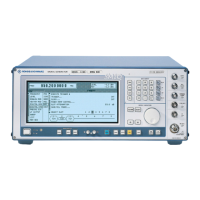SMIQ Contents
1125.5610.12 17 E-9
Tables
Table 2-1 Input sockets for the different types of modulation........................................................... 2.55
Table 2-2 Status messages in the case of a deviation from the rated value at the external modulation
inputs EXT1 and EXT2..................................................................................................... 2.56
Table 2-3 Parameter setting ranges................................................................................................. 2.69
Table 2-4 Phase shifts for
π/4DQPSK without coding...................................................................... 2.87
Table 2-5 Phase shifts for
π/4DQPSK with coding NADC, PDC, PHS, TETRA or APCO25 ........... 2.87
Table 2-6 Phase shifts for
π/4DQPSK with coding TFTS................................................................. 2.87
Table 2-7 Frequency deviations for FSK methods ........................................................................... 2.88
Table 2-8 Possible combination of modulation method and coding ................................................. 2.88
Table 2-9 Coding algorithms............................................................................................................. 2.89
Table 2-10 Examples of settings conflicts 2.90
Table 2-11 PRBS generators of modulation coder............................................................................. 2.93
Table 2-12 Logic function of signals BURST GATE and LEVEL ATT................................................ 2.98
Table 2-13 PRBS generators for PHS 2.116
Table 2-14 CDMA: channel numbers and their frequencies........................................................... 2.131
Table 2-15 Preferred CDMA-frequency channels according to J-STD-008 ..................................... 2.131
Table 2-16 PN generators for IS-95 reverse link .............................................................................. 2.134
Table 2-17 PN generators for W-CDMA 2.152
Table 2-18 Parameters of W-CDMA system 2.169
Table 2-19 Generator polynomials of uplink long scrambling code generators................................ 2.171
Table 2-20 Generator polynomials of uplink short scrambling code generators .............................. 2.172
Table 2-21 Mapping of the quaternary output sequence into the binary IQ level ............................. 2.172
Table 2-22 Hierarchical structure of 3GPP W-CDMA frames .......................................................... 2.174
Table 2-23 Structure of the DPDCH channel table depending on the overall symbol rate............... 2.206
Table 2-24 Change of crest factor in the case of clipping ................................................................ 2.213
Table 2-25 Default values for base station parameters.................................................................... 2.216
Table 2-26 Default values for mobile station parameters................................................................. 2.217
Table 2-27 References to measurement channels .......................................................................... 2.241
Table 2-28 OCNS channels 2.256
Table 2-29 PRBS generators for NADC 2.261
Table 2-30 PRBS generators for PDC 2.278
Table 2-31 PRBS generators for GSM 2.300
Table 2-32 PRBS generators for DECT 2.317
Table 2-33 LIST mode; Example of a list 2.393
Table 2-35 MEMORY SEQUENCE; Example of a list...................................................................... 2.398
Table 3-1 Common Commands ....................................................................................................... 3.14
Table 3-2 List of possible responses to *OPT? ................................................................................ 3.15
Table 3-3 Synchronization with *OPC, *OPC? and *WAI............................................................... 3.213
Table 3-4 Meaning of the bits used in the status byte .................................................................... 3.217
Table 3-5 Meaning of the bits used in the event status register ..................................................... 3.218
Table 3-6 Meaning of the bits used in the STATus:OPERation register ........................................ 3.219
Table 3-7 Meaning of the bits used in the STATus:QUEStionable register.................................... 3.220
Table 3-8 Resetting instrument functions....................................................................................... 3.223
Table 5-1 Measuring equipment and accessories.............................................................................. 5.1
Table 5-2 Range limits, main test frequencies with/without vector modulation .................................. 5.7
Table A-1 Interface function................................................................................................................A.2
Table A-2 Universal Commands.........................................................................................................A.3
Table A-3 Addressed Commands.......................................................................................................A.3
Table A-4 Interface functions (RS-232-C)...........................................................................................A.5

